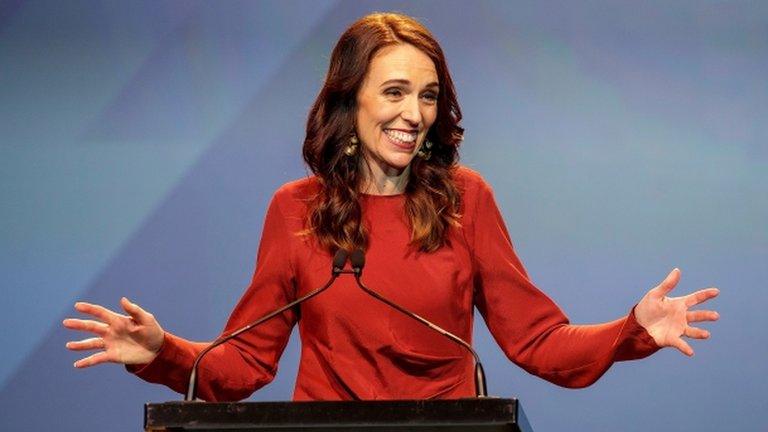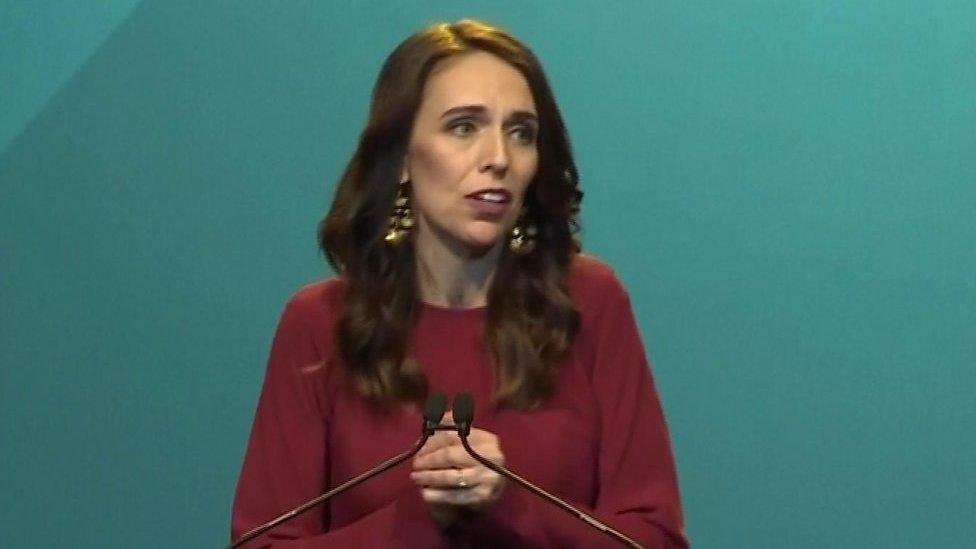Jacinda Ardern's majority may prove to be her biggest challenge
- Published
Jacinda Ardern: "We will not take your support for granted."
New Zealand Prime Minister Jacinda Ardern has led the centre-left Labour Party to a historic victory and is in a position to form the first single-party majority government since 1993. But political columnist Josh Van Veen says this result is likely to be her biggest challenge.
The preliminary results suggest the largest swing to an incumbent government ever. With Labour projected to win more than 61 seats in the 120-seat parliament, Ms Ardern is now in a position to form the first single-party majority government since 1993. This is a remarkable turnaround since the beginning of the year when opinion polls suggested the election would be close.
Ms Ardern's ability to make New Zealanders feel safe during a pandemic has been the main factor in her decisive victory. Before that, there was a very real perception that Ms Ardern could be a one-term prime minister as there was discontent towards her.
In her first term Ms Ardern relied on support from the populist New Zealand First and the centre-left Greens to form the government. Now, with New Zealand First not making it back, and the Greens not needed for a majority, she can go it alone.
Whether she will choose to is another question. Her leadership style is one that prefers compromise and consensus. She will be mindful that although the voters have given her a majority, this owes more to a quirk of the Mixed Member Proportional representation (MMP) voting system - a system which asks people to vote twice, for their preferred party and for their electorate, or constituency, MP - than to her popularity .
Labour has been helped by the fact that thousands of votes have been "wasted" on parties that did not gain representation. These votes are disregarded when allocating seats. In effect this means Labour has been able to secure a majority in Parliament with just under 50% of the vote.
It is likely the 2020 result is an aberration, and won't lead to a permanent shift in New Zealand political culture.
Jacinda Ardern's key leadership moments
Come the next election, Labour may again have to depend on the Greens or another party to retain power. If she were to take a more long-term perspective, then Ms Ardern may be inclined to keep the Greens on side by offering them some role in the next government. This would head off criticism from the left.
However, it remains uncertain what Ms Ardern plans to do with her second term. The Labour campaign was devoid of new ideas and light on policy. In 2017, she promised to lead "a government of transformation" but failed to deliver on that in office. In fact, child poverty and homelessness have worsened under her government.
Although motivated by a belief in social justice, Ms Ardern has a conservative disposition which makes her reluctant to embrace the kind of radical policies needed to address structural inequality.
Paradoxically, it is her conservative approach that persuaded many New Zealanders to vote for the Labour Party.
Despite having the biggest mandate of any prime minister in recent history, she will find it extraordinarily difficult to reconcile the demands of affluent middle-class voters with those of the poor. A major issue during the campaign was the Greens' proposal for a wealth tax. Ms Ardern categorically ruled this out, frustrating her progressive supporters.
For most of 2020, New Zealand was preoccupied with fighting Covid-19. Ms Ardern's success in uniting "the team of five million" - a reference to the population of the country - is a testament to her extraordinary abilities.
But with the virus under control, attention is turning to other issues such as unemployment and housing affordability. Voters now expect her to address these problems. That will be no easy task.
"Copeisolation" captures remote island lockdown
Josh Van Veen is an Auckland-based political writer and former member of NZ First, who worked as a parliamentary researcher to Minister of Foreign Affairs Winston Peters from 2011 to 2013
- Published17 October 2020

- Published17 October 2020

- Published17 May 2020
